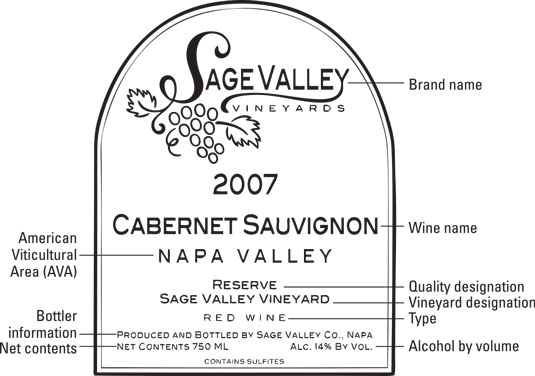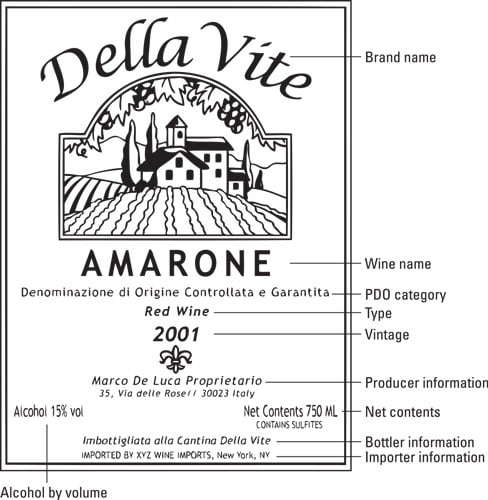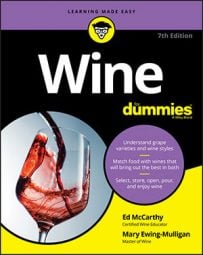But wine labels have an important purpose besides making their bottles stand out on the shelves. Wine labels contain information about the wine that’s inside the bottle — and knowing what the information means can make you a smarter buyer. Sometimes that information is straightforward — like the name of the region where the grapes grew — and sometimes it’s tricky, like long phrases in a foreign language that you don’t speak.
The mandatory sentences on wine labels
The government authorities in the United States (and other governments) mandate that certain information appear on the main label of all wine bottles — basic stuff, such as the alcohol content, the type of wine (usually red table wine or white table wine), and the country of origin. Such items are generally referred to as the mandatory. These items include the following:- A brand name
- Indication of class or type (table wine, dessert wine, or sparkling wine)
- The percentage of alcohol by volume (unless it’s implicit — for example, the statement table wine implies an alcohol content of less than 14 percent)
- Name and location of the bottler
- Net contents (expressed in milliliters; the standard wine bottle is 750 milliliters, which is 25.6 ounces)
- The phrase Contains Sulfites (with very, very few exceptions)
- The government warning (that we won’t dignify by repeating here; just pick up any bottle of wine, and you’ll see it on a label)
 Illustration by Lisa S. Reed
Illustration by Lisa S. Reed The label of an American varietal wine.
Wines made outside the United States but sold within it must also carry the phrase imported by on their labels, along with the name and business location of the importer.
The mandatory information required on U.S. and Canadian wine labels is also required by the E.U. authorities for most wines produced in European Union countries (although the wording of the warning label can vary). The labels of those E.U. wines must contain one additional item of information not required on labels of wines from elsewhere. This additional item is a phrase indicating that the wine comes from an officially recognized wine zone (see the next section for the scoop).
Indications of origin
The European Union has set up a system to recognize and protect agricultural products (such as wine, cheese, olives, hams, and so forth) that come from specific places so that companies in other places can’t make products with the same name and thus confuse consumers. Wines from all the classic wine regions of E.U. member countries (France, Italy, Spain, Germany, and so forth) are covered under this system. When you see the label of a European wine that’s from a recognized, protected place, you’ll find a phrase to that effect.Actually, two different phrases exist because European wines from protected places fall into two categories:
- Wines named for places where production is highly regulated so that the very place-name of the wine not only defines the territory of production but also connotes the wine’s grape varieties, grape-growing methods, and winemaking techniques
- Wines that carry the protected names of larger places where winemakers have more freedom in terms of the grape varieties and production methods they use
- Protected Designation of Origin (PDO), for the most regulated wines. The classic wines mentioned in the sidebar “Decoding common European place-names,” for example, are all in this category.
- Protected Geographic Indication (PGI), for the less regulated wines from registered regions.
But in practice, the situation is much more complicated, especially at the moment. How so?
- For one thing, each country can, and does, translate the words Protected Designation of Origin and Protected Geographic Indication into its own language on its labels.
- Second, because these E.U. designations went into full effect only in 2012, some wine labels still carry the phrases that were previously used by each country to designate a wine’s category of origin.
- And finally, each country can permit its wineries to continue using the former phrases rather than the new phrases.
Incidentally, the phrase for a registered place-name in the United States is American Viticultural Area (AVA). But the phrase doesn’t appear on wine labels. Nor does any such phrase appear on labels of Australian or South American wines. Nor do two different degrees of regulations exist, as they do in the European Union.
Label terms that mean PDO (Protected Designation of Origin)
Here are the phrases — first in the new terminology and then in the original terminology — that you might find on labels of PDO wines from the major European countries. In all cases, the phrases translate more or less as “Protected Designation of Origin”:
- France: Appellation d’Origine Protégée (AOP) or Appellation Contrôlée or Appellation d’Origine Contrôlée (AC or AOC, in short)
- Italy: Denominazione di Origine Protetta (DOP) or Denominazione di Origine Controllata (DOC); and for certain wines of an even higher status, Denominazione di Origine Controllata e Garantita (DOCG)
- Spain: Denominación de Origen Protegida (DOP) or Denominación de Origen (DO), as well as Denominación de Origen Calificada (DOCa) for regions with the highest status (of which only two exist: Rioja and Priorat)
- Portugal: Denominação de Origem Protegida (DOP) or Denominação de Origem Controlada (DOC)
- Germany: Qualitätswein; and for wines of higher ripeness, Prädikatsweine
 Illustration by Lisa S. Reed
Illustration by Lisa S. ReedThe label of a European wine to be sold in the United States.
Label terms that mean PGI (Protected Geographic Indication)
Here are the phrases — first in the new terminology and then in the original terminology — that you might find on labels of PGI wines from the major European countries. In all cases, the phrases translate more or less as “Protected Geographic Indication”:
- France: Indication Géographique Protégée (IGP) or Vin de Pays followed by the name of an approved area
- Italy: Indicazione Geografica Protetta (IGP) or Indicazione Geografica Tipica (IGT) and the name of an approved area
- Spain: Indicación Geográfica Protegida (IGP) or Vino de la Tierra followed by the name of an approved area
- Portugal: Indicaçõa Geográfica (IG) to refer to a region, but on a label, the original phrase, Vinho Regional (regional wine) and the name of an approved area
- Germany: Landwein
Some optional label lingo
Besides the mandatory information required by government authorities, all sorts of other words can appear on wine labels. These words include meaningless phrases intended to make you think that you’re getting a special quality wine, and words that provide useful information about what’s in the bottle. Sometimes the same word can fall into either category, depending on the label. This ambiguity occurs because some words that are strictly regulated in some producing countries aren’t regulated at all in others.Vintage
The word vintage followed by a year, or the year listed alone without the word vintage, is the most common optional item on a wine label (refer to Figure 4-2). Sometimes the vintage appears on the label itself, and sometimes it has its own small label closer to the neck of the bottle.The vintage year is nothing more than the year in which the grapes for a particular wine grew; the wine must have 75 to 100 percent of the grapes of this year, depending on the country of origin. (Non-vintage wines contain wines from more than one year.) But an aura surrounds vintage-dated wine causing many people to believe that any wine with a vintage date is by definition better than a wine without a vintage date. In fact, no correlation exists between the presence of a vintage date and the wine’s quality.
Generally speaking, what vintage a wine is — that is, whether the grapes grew in a year with perfect weather or whether the grapes were meteorologically challenged — is an issue you need to consider (a) only when you buy top-quality wines, and (b) mainly when those wines come from parts of the world that experience significant variations in weather from year to year — such as many European wine regions.
Reserve
Reserve is our favorite meaningless word on U.S. wine labels. The term is used to convince you that the wine inside the bottle is special. This trick usually works because the word does have specific meaning and does carry a certain amount of prestige on labels of wines from many other countries:- In Italy and Spain, the word reserve (or its foreign language equivalent, which looks something like reserve) indicates a wine that has received extra aging at the winery before release. Implicit in the extra aging is the idea that the wine was better than normal and, therefore, worthy of the extra aging. Spain even has degrees of reserve, such as Gran Reserva.
- In France, the use of reserve isn’t regulated. However, its use is generally consistent with the notion that the wine is better in quality than a given producer’s norm.
In the United States, the word reserve has historically been used in the same sense — as in, Beaulieu Vineyards Georges de Latour Private Reserve, the best Cabernet that Beaulieu Vineyards makes. But these days, the word is bandied about so much that it no longer has meaning. For example, some California wines labeled Proprietor’s Reserve are the least expensive wines in a particular producer’s lineup and some of the least expensive wines, period. Other wines are labeled Special Reserve, Vintage Reserve, Vintner’s Reserve, or Reserve Selection — all utterly meaningless phrases.
Estate-bottled
Estate is a genteel word for a wine farm, a combined grape-growing and winemaking operation. The words estate-bottled on a wine label indicate that the company that grew the grapes and made the wine also bottled the wine. In other words, estate-bottled suggests accountability from the vineyard to the winemaking through to the bottling. In many countries, the winery doesn’t necessarily have to own the vineyards, but it has to control the vineyards and perform the vineyard operations.Estate-bottling is an important concept to those who believe that you can’t make good wine unless the grapes are as good as they can possibly be. If we made wine, we’d sure want to control our own vineyards.
We wouldn’t go so far as to say that great wines must be estate-bottled, though. Ravenswood Winery — to name just one example — makes some terrific wines from the grapes of small vineyards owned and operated by private landowners. And some large California landowners are quite serious about their vineyards but don’t make wine themselves; they sell their grapes to various wineries. None of those wines would be considered estate-bottled.
Sometimes French wine labels carry the words domaine-bottled or château-bottled (or the phrase mis en bouteille au château/au domaine). The concept is the same as estate-bottled, with domaine and château being equivalent to the U.S. term estate.
Vineyard name
Some wines in the medium-to-expensive price category — costing about $25 or more — might carry on the label the name of the specific vineyard where the grapes for that wine grew. Sometimes one winery will make two or three different wines that are distinguishable only by the vineyard name on the label. Each wine is unique because the terroir of each vineyard is unique. These single vineyards might or might not be identified by the word vineyard next to the name of the vineyard.Italian wines, which are really into the single-vineyard game, will have vigneto or vigna on their labels next to the name of the single vineyard. Or they won’t. It’s optional.

